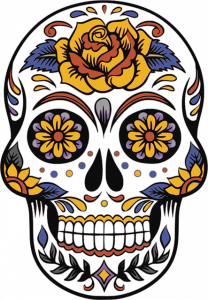The Day of the Dead vs. Halloween
El Día de los Muertos, of Day of the Dead, is not a Mexican version of the U.S. Halloween. They both have parades, costumes, celebrations., music, dancing, and lots of food. But the background is quite different. In many Latin countries, The Day of the Dead is believed to be a time when the line between the real world and the spirit world disappears. For two days, the souls of the dead awaken and visit the living world. The living welcome them as honored guests, invite them to the celebrations, and leave the deceased’s favorite food and other offerings at the grave-site. It is a time to honor the dead relatives, bring them back and include them in the celebrations. It is a happy time, remembering those who have passed away, but maybe will rejoin the living if only for a day. Offerings are an important part of El Dia de los Muertos. Families will often have an altar at home honoring deceased relatives. And this is a time to clean and decorate graves.
The Day of the Dead is believed to be a time when the line between the real world and the spirit world disappears. For two days, the souls of the dead awaken and visit the living world. The living welcome them as honored guests, invite them to the celebrations, and leave the deceased’s favorite food and other offerings at the grave-site. It is a time to honor the dead relatives, bring them back and include them in the celebrations. It is a happy time, remembering those who have passed away, but maybe will rejoin the living if only for a day. Offerings are an important part of El Dia de los Muertos. Families will often have an altar at home honoring deceased relatives. And this is a time to clean and decorate graves.
El Día de los Muertos originated perhaps 3,000 years ago in Columbian Mesoamerica. The Aztecs held a cyclical view of the universe and saw death as an integral, ever-present part of life. In medieval Spain, people would bring wine and “pan de animas” (spirit bread) to the graves of loved ones on All Souls Day.
Our Halloween probably originated with the Celts, perhaps 2,000 years ago. Their New Year began on November 1. So, October 31 was the end of the year and the boundary between old and new – perhaps between the dead and the living. Bonfires were built to burn crops and animals as a sacrifice to the gods in hopes of a better new year. The Catholic Church adopted this into their celebrations with two Catholic holidays: All Saints Day, Nov. 1 and All Souls Day, Nov. 2.
 But today, it has lost much of the old traditions. We no longer take time to remember past relatives or include them in our celebration. it is a time to decorate one’s house with signs of the dead and ghosts, to visit neighborhood homes and businesses to collect candy, and for older Americans to dress in costumes and go to a party.
But today, it has lost much of the old traditions. We no longer take time to remember past relatives or include them in our celebration. it is a time to decorate one’s house with signs of the dead and ghosts, to visit neighborhood homes and businesses to collect candy, and for older Americans to dress in costumes and go to a party.
And the industry officials say that one quarter of all candy sold annually in the U.S. is purchased for Halloween.

Thanks for the information comparing the Day of the Dead and Halloween.
Thanks for the comment, Lesley. It’s an interesting time of the year – and for candy lovers, the top holiday.
jim